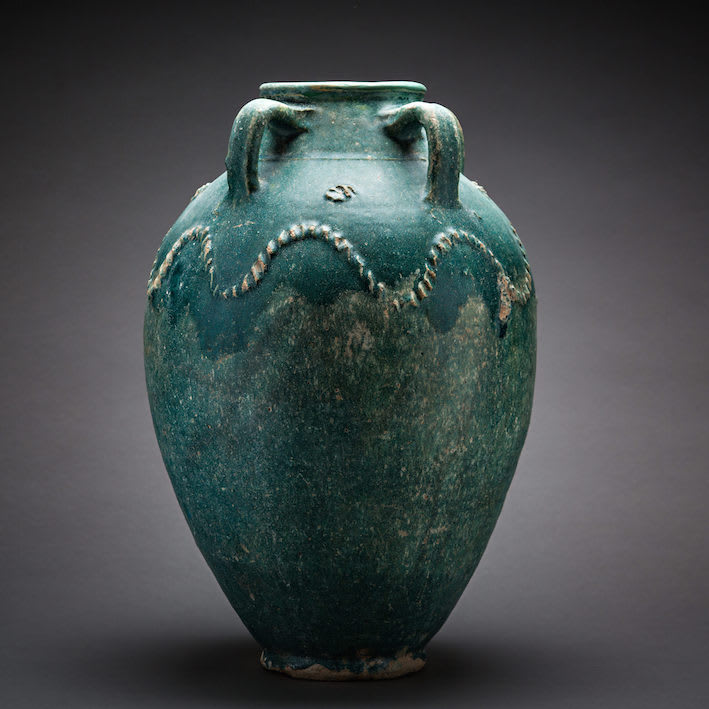Parthian Green-Glazed Amphora, 100 BCE - 300 CE
Glazed Terracotta
height 50.2 cm
height 19 3/4 in
height 19 3/4 in
SF.123
Further images
The Parthians defeated the Seleucids towards the end of the third century BC and went on to found an empire that stretched from the Mediterranean to the Indus. Formerly a...
The Parthians defeated the Seleucids towards the end of the third century BC and went on to found an empire that stretched from the Mediterranean to the Indus. Formerly a Central Asian nomadic people they acquired great wealth through their control of caravan cities along the Silk Route. Led by the Arsacid Dynasty, they were Rome’s strongest opponents in the East. The Romans disputed territory in Syria, Armenia and Mesopotamia but were often defeated in battle by the superiority of the Parthian cavalry. In contrast to their hostile relationship with Rome, the Parthians seem to have courted the favour of the Chinese Han Dynasty. As early as the second century BC the Chinese explorer Zhang Qian visited Parthia and described it as an advanced urban civilisation. Embassies were sent in both directions and trade with China flourished. A detailed account of Parthian civilisation has yet to be written- partly because so little of their own literature has survived. Historians are forced to rely on foreign histories and numismatic evidence. However it is clear from the coins alone that Parthian kings were consciously modelling themselves on their Achaemenid predecessors and attached great significance to the visual arts.
Glazed turquoise/green vessels are one of the most distinctive Parthian art forms. Glazed ceramics were extremely rare in the Middle East prior to the Islamic period. Only in China were glazed wares common at this early date and it is possible that diplomatic and trading ties encouraged this development in the Parthian lands. Despite their dazzling beauty these wares were used for practical purposes such as the storage and transportation of liquids and grains. The colour was created from copper and iron oxides mixed in an alkaline glaze. This was applied on top of a fine white paste so that the reddish surface of the clay would not show through. The shapes of the vessels reveal a reliance on Greek and Mesopotamian forms- although it is not easy to separate these two traditions as the eastern Greeks had themselves borrowed ideas from the Mesopotamians. It has also been suggested that in their colour and form there is some attempt to imitate metallic vessels which were undoubtedly more expensive. The green glaze has been likened to the patina that bronze acquires over time and some of the decorative elements have been compared to twisted metal.
This amphora is exceptional for its size and the quality of the glaze. The tone of the turquoise becomes lighter towards the base and the surface has a wonderful iridescent glow. It has four handles attached to the short neck and the upper part of the body. The rim projects slightly and has an indented band where the glaze is slightly darker. A ‘zig-zag’ motif runs around the vessel just below the handles and has been pinched- perhaps to resemble work in metal. Four irregular shaped ovals- also pinched- have been applied between the handles. Despite small losses to the applied decoration the amphora is in excellent condition. (AM)
Glazed turquoise/green vessels are one of the most distinctive Parthian art forms. Glazed ceramics were extremely rare in the Middle East prior to the Islamic period. Only in China were glazed wares common at this early date and it is possible that diplomatic and trading ties encouraged this development in the Parthian lands. Despite their dazzling beauty these wares were used for practical purposes such as the storage and transportation of liquids and grains. The colour was created from copper and iron oxides mixed in an alkaline glaze. This was applied on top of a fine white paste so that the reddish surface of the clay would not show through. The shapes of the vessels reveal a reliance on Greek and Mesopotamian forms- although it is not easy to separate these two traditions as the eastern Greeks had themselves borrowed ideas from the Mesopotamians. It has also been suggested that in their colour and form there is some attempt to imitate metallic vessels which were undoubtedly more expensive. The green glaze has been likened to the patina that bronze acquires over time and some of the decorative elements have been compared to twisted metal.
This amphora is exceptional for its size and the quality of the glaze. The tone of the turquoise becomes lighter towards the base and the surface has a wonderful iridescent glow. It has four handles attached to the short neck and the upper part of the body. The rim projects slightly and has an indented band where the glaze is slightly darker. A ‘zig-zag’ motif runs around the vessel just below the handles and has been pinched- perhaps to resemble work in metal. Four irregular shaped ovals- also pinched- have been applied between the handles. Despite small losses to the applied decoration the amphora is in excellent condition. (AM)







